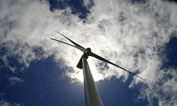US wind farm energy up in the air over climate change, says study
 Measurements from wind towers across the midwest show average and peak winds may have been slowing since 1973
Measurements from wind towers across the midwest show average and peak winds may have been slowing since 1973The great gusting winds of the American midwest – and possibly the hopes for the most promising clean energy source – may be dying, in part because of climate change, according to a new report.
A study, due to be published in August in the peer-reviewed Journal of Geophysical Research, suggests that average and peak winds may have been slowing across the midwest and eastern states since 1973.
The authors of the study note that their findings are preliminary and some of their data is ambiguous. But the study, based on measurements gathered from wind towers across the midwest raises the possibility of yet another new side effect from global warming: declining wind speeds.
“We have noted there have been some periods in the past … where there was a pretty substantial decrease in wind speed for 12 consecutive months,” Eugene Takle, the director of the climate science initiative at Iowa State University and one of the authors of the study, said. “We suspect that it’s some large-scale influence that we don’t yet understand.”
Areas of the midwest have seen a 10% decline in average wind speed over the past decade. Some places – such as Minnesota – have seen a jump in the number of days where there was no wind at all.
Takle said climate modelling suggested a further 10% decline in wind levels could occur over the next four decades. “Generally we expect there will probably be a decline in wind speeds due to climate change.”
The sharpest fall off in wind speeds recorded in the study occurred in the eastern United States including Ohio, Indiana, Kansas, Michigan, Illinois, Louisiana, northern Maine, western Montana and Virginia.
Other areas, like west Texas, which is the heart of America’s wind power industry have been relatively unaffected, the study found.
The yet-to-be-published study was first reported by the Associated Press which also noted that the research was preliminary.
Takle noted that data could be skewed by changes in instruments for measuring wind, or reforestation, which could also slow wind speeds.
Other scientists have also raised doubts about the findings.
But if the findings are borne out, the dying winds could deliver a serious setback to plans to expand the use of the renewable energy.
The US is the world’s largest producer of wind power, and investment in the sector had explosive growth before the economic downturn, hitting $17bn last year. Wind turbines are now a common sight on high rises across many American states.
But a 10% fall in peak winds could translate into a 27% reduction in energy, Takle said. “On moderately windy days when wind turbines are struggling to get as much as they can out of the wind available and they are not letting any extra power go through that could make a big difference.”
Wind industry analysts downplayed the potential impact of a reduction in wind levels in some regions of the US. “I don’t think that at this point you could definitively say there are going to be across the board decreases in wind,” said Michael Goggin, an industry analyst for the American Wind Energy Association. “The abundance and diversity of wind resources in the United States is so great. We are called the Saudi Arabia of wind for a reason. There are enough different climate regimes that even if some are negatively affected – and at this point that is speculative – others could do better.”
Gavin Schmidt, a climate scientist at Nasa’s Goddard Institute of Space Studies, told the Guardian the study had yet to establish a clear pattern of declining winds, and that it was too soon to be thinking of the effects on wind energy industry.
“It’s still very preliminary. My feeling is that it is way too premature to be talking about the impact that this makes.
You can return to the main Market News page, or press the Back button on your browser.

